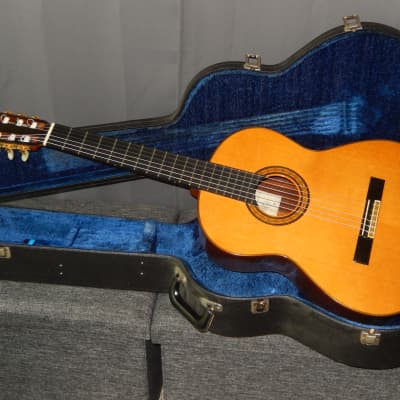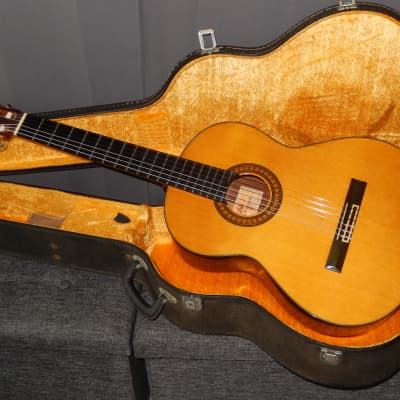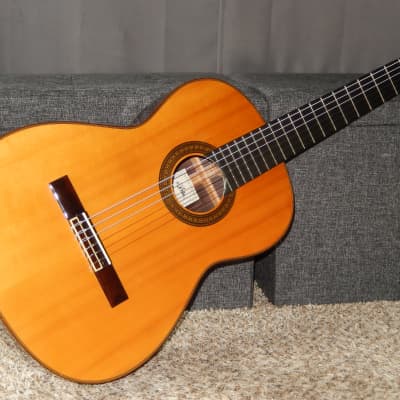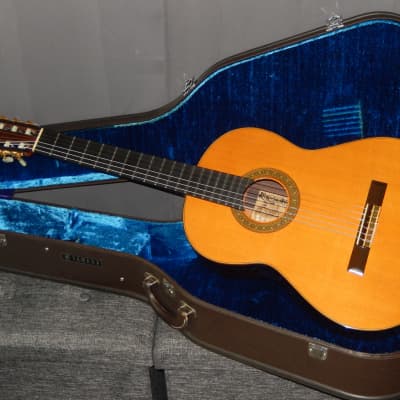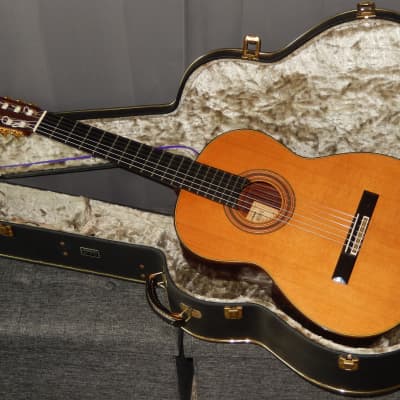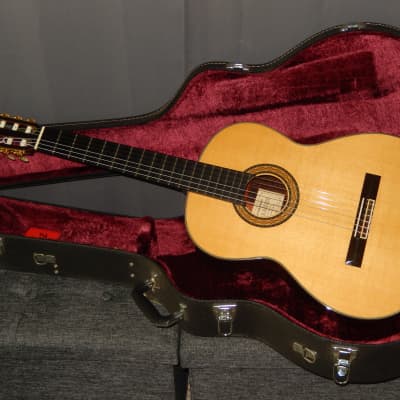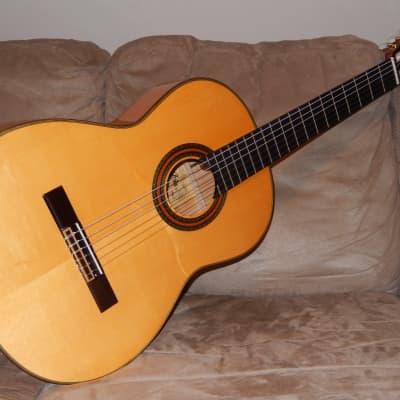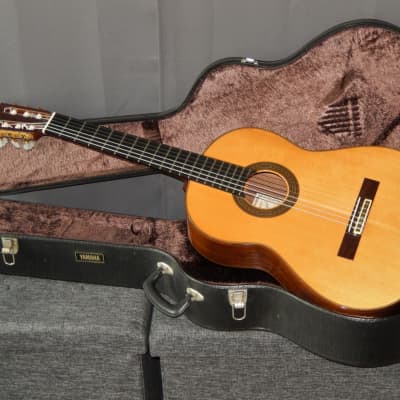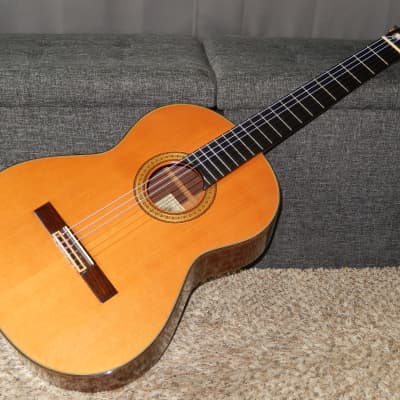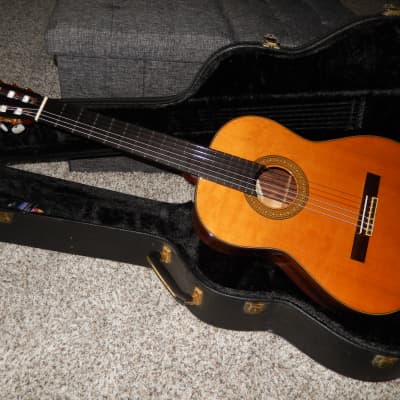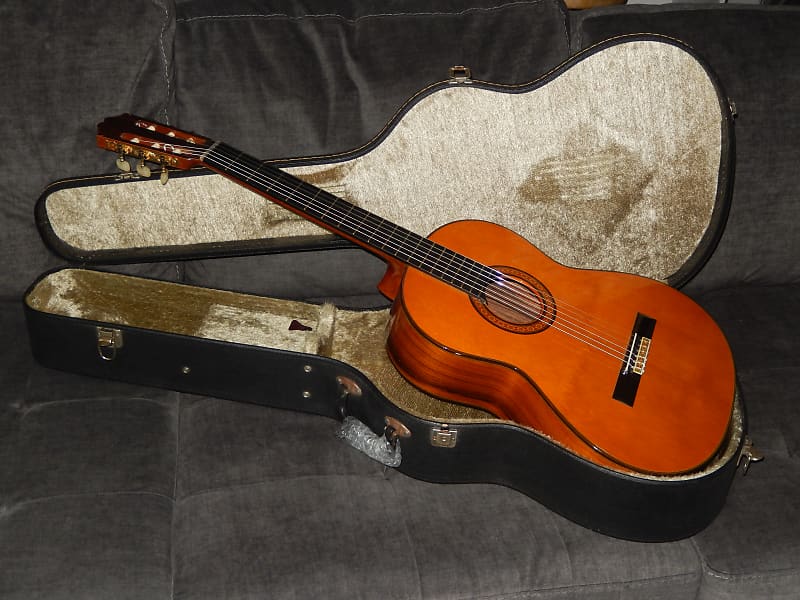

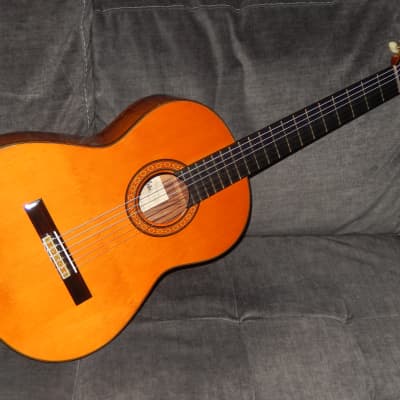
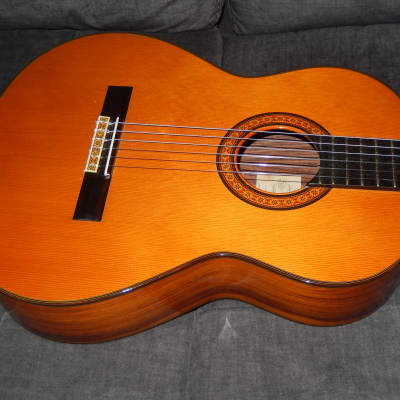
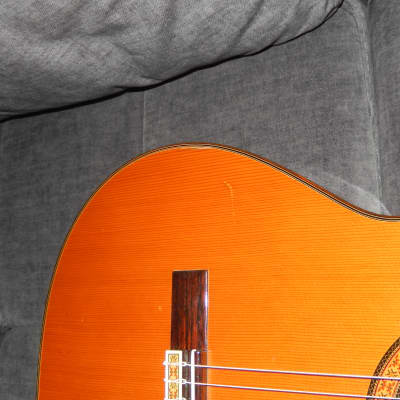
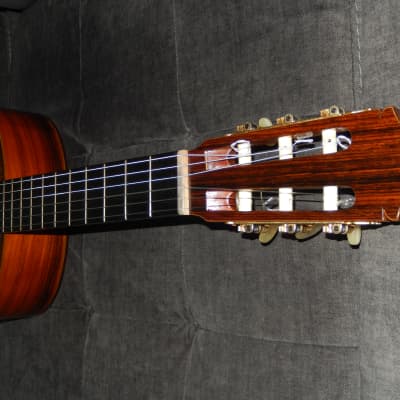
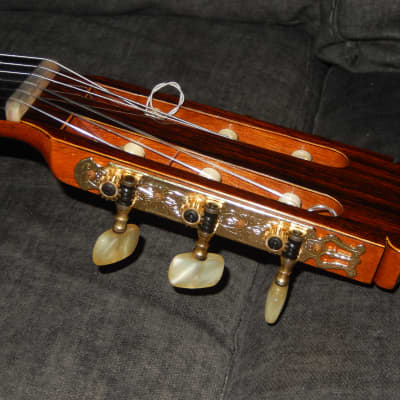
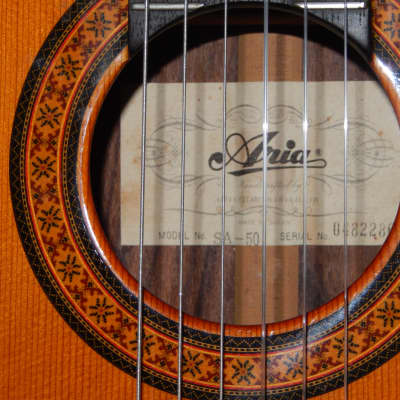
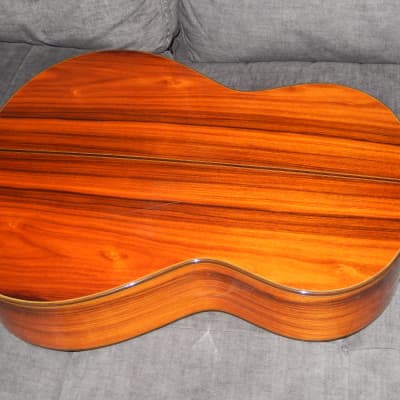
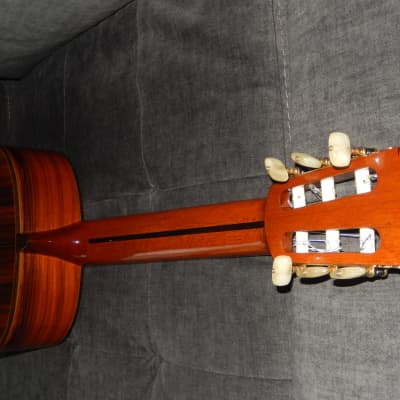
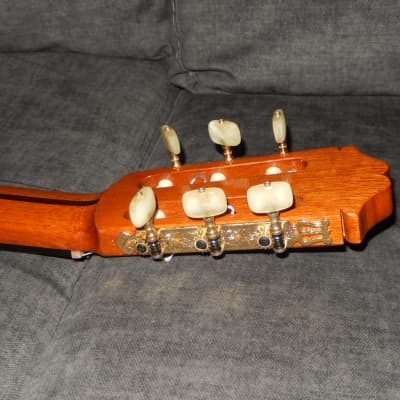
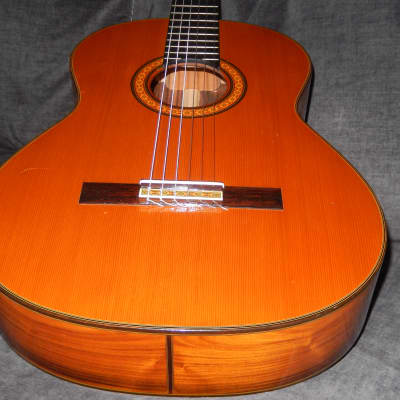
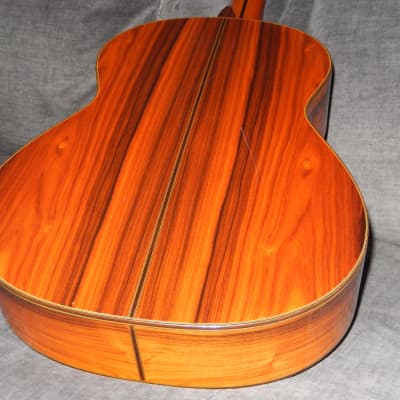
Aria SA-50
This guitar was hand made in mid 1970s for Shiro Arai & Co, in cooperation between Takamine and Masaru Kohno workshops, based on Masaki Sakurai's designs and under his personal supervision.
Since the origination of his ARAI & CO. INC in 1956, Shiro Arai was cooperating with several classical guitar makers. In early 1960s he was already representing Masaru Kohno workshop on international markets. Until today Arai & Co. is the only authorized international distributor of Kohno and Sakurai guitars.
After winning the 1st prize at international competition in 1967 in Belgium, international markets were wide open for Masaru Kohno “brand name”. He was smart enough to take full advantage of his fame turning few new ideas into great profits. One of these ideas was to purchase Takamine co, in 1968 and placing his pupil Mass Hirade at its helm. Another idea was a line of very high-grade guitars designed for domestic market, sold at moderate prices, hence affordable to average Japanese citizens. Originally (1968) named Yamato guitars, they became Aranjuez guitars by early 1970s. While most models were entirely made by Takamine workshop, top Aranjuez guitars were assembled at Kohno’s workshop with soundboards also made at Kohno’s workshop. Until 1978 all Aranjuez guitars had Kohno stamp on their labels.
During late 1960s and early 1970s Aria AC classical guitars were made either by Ryoji Matsuoka’s or Masaru Matano’s workshops. Sometime around 1974/75 Shiro Arai started hiring other luthiers like Masaru Takeiri or Oguri Toshikazu, while Aria's AC series models were being replaced by SA and AG models, manufactured under Masaru Kohno workshop umbrella. It was Masaki Sakurai who was designing and supervising production of AG and SA series models, most of which were entirely by Takamine co. High-end models (like Aria AG80, SA80) had soundboards made at Masaru Kohno workshop by Masaki Sakurai himself. Masaki was also responsible for their final assembly. Only these very top Aria models had (copyright protected) Kohno’s design rosettes and bridge decoration. All AG and SA models had Masaki Sakurai’s design headstock, the same he uses until today.
Currently Masaki Sakurai is one of very top Japanese luthiers. He has won international competition in 1988 in Paris and after his uncle's death (in 1998) he took over Masaru Kohno workshop, which he runs until today. Masaki still supervises production of Aranjuez guitars, still assembling and making soundboards for top-of-the-line Aranjuez 725 model (hence sold with Sakurai’s personal label inside).
Despite its age this Aria SA-50 guitar remains in at least good cosmetic and perfect working condition. The most conspicuous cosmetic flaws are located on its top, in the area normally covered by player’s arm. These are very light linear dents/scratches, that don’t penetrate the wood.
This guitar being priced 50 000 yen in 1975, was quite expensive instrument.
Just like all Aria guitars, this one was way underpriced. It sounds better than many much higher priced guitars made by leading Japanese luthiers of that era. It is simply an amazing instrument that can easily beat many $5000 guitars currently sold in USA. It offers great volume combined with ultra-lyrical, super-charming, very colorful tonality, high level of note clarity and separation, and very impressive sustain. It is one of those “hard to put down” guitars. I can’t imagine the player who wouldn’t be happy playing this gorgeous instrument.
SPECIFICATIONS:
Top: High Grade Solid Spruce/lacquer
Back & sides: Brazilian Rosewood Double-Plate
“Laminated” is quite unfortunate term regarding Japanese made guitars. These "laminates" were made from 2 layers of solid wood glued together with natural resins. They were made so well that they performed as good as solid woods while being far less expensive in guitar production and far more resistant to cracking in regular use.
Neck: Mahogany
Fingerboard: Ebonized Rosewood
With at the nut: 52 mm
Scale: 658 mm
Action is set to 3.7 mm under E6 and 3.20 mm under E1 with practically no extra room on the saddle.
This guitar will be shipped in used hard case in still good condition, although of minimal value.
The key to understand value of vintage Japanese guitars is to acknowledge galloping price inflation (devaluation of Japanese yen) during 1960s & 1970s. This inflation slowed down in 1980s.
During 1960s and most of 1970s model numbers of Japanese guitars were strictly interconnected with their prices in Japanese yen. By early 1980s and during following decades model numbers were no longer strictly associated with their prices. Some Japanese guitar makers introduced model names instead of model numbers. Others were still using model numbers with addition of letters and/or other symbols.
It is important to understand that two Yamaha GC10 guitars made 10 years apart are two instruments of totally different class. The same applies to any other Japanese maker/brand.
Any guitar priced 100 000 yen in 1970 (labelled usually as No10) would be priced 200 000 yen in 1975 (relabeled to No20 or 2000), 300 000 yen in 1977 (labelled as No3, No30 or 3000). Starting in 1977 Masaru Kohno introduced his new models No40 priced 400 000 yen and No50 priced 500 000 yen. By 1984 Kohno started using model names instead numbers and was raising their prices as he was pleased. The very top model 50 became model “Special”, and a decade later it became model “Maestro”. Naturally, all other Japanese guitar makers were doing the same pricing (labelling) upgrades.
Knowing all of that, you can bet on that Masaru Kohno No50 made in 1982 is practically the same grade instrument as Kohno No20 made in 1972, or Kohno no 30 made in 1975.
In 1970 the lowest Ryoji Matsuoka (all laminates) model was 10, followed by (solid top) models 15, 20, 25, 30, 40, 50, 60, 80 and (all solid woods) models 100 and 150. Models 60 and 80 were made with non-solid figured Brazilian Rosewood (double) b/s and top model 150 was the only one made with solid figured Brazilian Rosewood b/s.
In 1980 the lowest Matsuoka model was (all laminates) 20, followed by (solid top) models 30,40,50, 60 and all solid woods models 80,100,150 and 200. By 1990 the lowest Matsuoka model was M40 and the highest was M300. By 2010 the lowest Matsuoka model was M50 and the top model was M270.
You can bet that Ryoji Matsuoka model 50 from 1980 is of the same grade as model M100 from 2000, model 100 from 1980 is of the same grade as model M150 from 2000, model 150 from 1980 is of the same grade as M200 from 2000 and model 200 from 1980 is of the same grade as model M300 from 2000.
It is important to mention that if modern era luthiers are using 40+ years old woods to make an “all solid” wood classical guitar, its price is minimum $8000.
All vintage guitars made with Brazilian Rosewood are especially precious, including those made straight grain varieties and those with non-solid b/s.
Because response and tonal properties of Spruce soundboards are improving over time, long seasoned Spruces are far more precious than long seasoned Cedars.
It is not that very difficult to find out what are current prices of such guitars made by world’s leading luthiers.
History of Aria Guitars
One day, a friend came to visit Shiro's apartment with a guitar. Shiro was expecting to hear Koga-type Japanese popular music, but instead his friend started to play a piece by Bach. From this moment, he had been inspired by the sound of this instrument forever.
The very next day, Shiro bought his first guitar, costing over two months salary and began to teach himself to play. Now playing day and night, his passion for the guitar brought him to a famous classical guitar master in Nagoya, and soon became one of his students.
Shiro started work for a trading company in 1947, aged 17. In 1953, Shiro and two of his colleagues resigned their positions and founded their own trading firm. After the fledgling company failed after just one year, Shiro found himself homeless with nothing but his guitar. In order to live and settle the outstanding debts from this first business he started to teach the guitar.
In 1954 unable to buy guitars, music and strings in Japan's music stores, Shiro started to import classical guitars, Augustine guitar strings, and musical scores for himself and his students. These were the first classical guitars imported into post-war Japan and included instruments from renowned makers Jose Ramirez and Hermann Hauser. Recognizing an increasing demand for guitars from friends and players throughout Japan, Shiro grasped the opportunity to start his own business. On August 2nd, 1956, ARAI & CO., INC was founded.
At this time, although demand for classical guitars and accessories were increasing, it was still comparatively low and business was supplemented with other products including woolen material.
The name, "ARIA", which means expressive melody, was first used in 1958 when Arai exported Japanese built classical guitars fitted with steel strings to South East Asia in 1963. Also the letters of his name "ARAI" were just switched around to "ARIA as he recalled.
Shiro embarked on a tour of the US with two of the best Japanese KOHNO guitars. At that time Japanese guitars had a poor reputation for developing body cracks and warped necks after being exposed to drier conditions abroad. It was Shiro's intention to prove how good Japanese guitars were by performing and showing to fellow guitarists, teachers and music shops. After two months these guitars also started to crack.
Even the best available Kohno guitars faced the same problem. Shiro took these cracked guitars back to Japan to show their makers just how vital it is to use properly seasoned tone woods. This trip gave Shiro the experience and knowledge to improve the quality of guitars and export Japanese guitars worldwide.
It was as early as the late 50's when Arai started to import Fender guitars and amplifiers from the US, although at that time the Japanese market was not quite ready for the electric guitar! With the advent of rock n' roll demand for electric guitars took-off. Arai released its first ARIA brand electric guitars in 1963. Exporting to the US followed with models including the 1532T and 1802T.
To counter the decline of the solid body electric guitar boom, Arai released the Aria Diamond series hollow body semi-acoustic guitars. Aria Diamond was named after the imitation diamond inlayed into the headstock. This series lead to the release of the 1202 and 1302 models in 1966 and caused nothing short of a sensation in Japan. From 1967 Aria added a variety of models including the solid body 1962T, R-320, and violin shaped 12-string and bass guitars, and a full acoustic guitar, the 1262.
In 1975, Aria Pro II was developed from Aria's custom shop making high-end models for professional users. In 1976, Aria Pro II released its first original model, the PE-1500.
PE (Prototype Line) is a classic Aria design, also known as the legendary masterpiece, it featured an arched top, and all maple carved body with Aria's original "heel-less neck and DiMarzio Super Distortion Humbucking Pickups. Primarily designed for tone and playability, the PE series has been modified to match today's trends while keeping its original features and timeless design.
In 1978, Aria Pro II released another long-selling model, the SB-1000. The SB-1000 was highly regarded throughout the world and came to represent everything that was good about Aria and Japanese guitar building. Featuring a Canadian Ash body with neck through body and, to enhance playability, a heel-less neck. For its original tone, SB featured the Aria original BB circuit. Its exotic see-through finish and the eye position marks make the SB amongst the most distinctive basses ever made.
Aria Pro II led the way with the 80's shift to Hard Rock and Heavy Metal. Releasing many models such as XX, ZZ and U-1. Whilst not abandoning their routes also re-established the semi-acoustic guitar models, FA and TA. The 80s, also saw the introduction of the famous IGB (SB INTEGRA) bass series.
In the early 1990s, after the heavy metal rush, Aria Pro II released one of its favorite original models, the MA series to reinforce the PE and SB line-ups. MA series bodies are constructed with innovative crystal shaped carved top and back.
Continuing its remarkable progress, Aria released the very unique concept of the SWB (electric upright bass) series to the world in 1992. The SWB range offers compact modern design and features the Fishman custom bridge Piezo pickup and active tone circuit.
Aria has been at the forefront of guitar and Japanese guitar building excellence for 50 years, which means a wealth of experience and acquired expertise. The core value remains the same today, to constantly strive to achieve a higher level.
Reverb Buyer Protection
Reverb has your back if your item is lost, damaged, or doesn't match its description. Simply report any issues within 7 days and we'll help you get a full refund.Learn more about Reverb Buyer Protection.
| Listed | 3 years ago |
| Condition | Very Good (Used) Very Good items may show a few slight marks or scratches but are fully functional and in overall great shape.Learn more |
| Brand | |
| Model |
|
| Finish |
|
| Categories | |
| Year |
|
| Made In |
|
| Body Shape |
|
